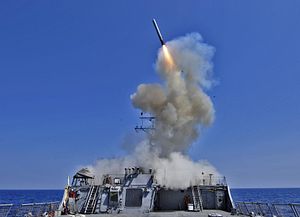Japan’s Prime Minister Kishida Fumio has announced plans to bulk-order 400 Tomahawk cruise missiles from the United States in fiscal year 2023, starting in April, as part of his government’s plan to bolster the counterstrike capability of the Japan Self-Defense Forces (JSDF).
The announcement came as a surprise to many because the Ministry of Defense (MoD) in Tokyo usually does not officially disclose the number of missiles held or acquired by the JSDF.
“The number of missiles and unit prices held by the SDF has not been published in order not to reveal the warfighting sustainability of the SDF,” Kishida said at a House of Representatives Budget Committee session in Tokyo on February 27.
“But we have decided to announce it this time because the public is very interested in Tomahawk [missiles], and the United States will also announce the maximum amount of [Tomahawk] missiles to be sold to Japan as part of [explanatory] process for the U.S. Congress,” Kishida explained.
Defense Minister Hamada Yasukazu said at a regular press conference on February 14 that the MoD will make a blanket contract with Raytheon Technologies Corp to acquire Tomahawks through the U.S. government’s foreign military sales program during the next financial year.
The MoD secured 211.3 billion yen ($1.55 billion) to procure U.S.-made long-range Tomahawk cruise missiles. The MoD said it will deploy the Tomahawks in fiscal year 2026-27. Tokyo is expected to acquire the latest model Tomahawk Block V to be equipped onto Japan Maritime Self-Defense Force (JMSDF) Aegis-equipped destroyers.
According to Janes Weapons: Naval, the Tomahawk has a range of between 550 and 2,500 kilometers, depending on the variant. This gives Japan the range to strike adversaries in the region. The most recent versions of the missile – designated Block IV – are integrated with a datalink to enable the switching of targets while in flight and are capable of loitering for “prolonged duration,” according to Janes.
The Block V variant also provides the entry point for two additional sub-variants: the Block Va variant, which adds a seeker kit to enable the prosecution of moving maritime targets, and the Block Vb variant, which introduces a new multi-effects lethal package in place of the existing unitary warhead, according to Janes. It is still unclear which variant Japan will buy at this stage.
The Tomahawk will serve as a “bridge” for the JSDF until the deployment of domestically produced missiles.
The MoD plans to deploy an extended-range version of the domestically developed Type 12 Surface-to-Ship Missile as a stand-off missile. This missile will be operated by the army, the navy, and the air force in different variants. The ministry aims to deploy the ground-launched type in 2026, the ship-launched type in 2028, and the aircraft-launched type in 2030.
The MoD has been also working on a so-called hypervelocity gliding projectile (HVGP). The weapon, which is expected to have a range of several hundred kilometers to several thousand kilometers, is designed for launch using a rocket motor, with the projectile, or glide vehicle, separating from it at a high altitude and then gliding at hypersonic speeds to its target.
The HVGP, which is intended to be used in defending Japan’s remote southwestern islands, will be developed in two variants – Block I and Block II – with the latter featuring greater speed and maneuverability, according to the ministry’s Acquisition, Technology and Logistics Agency. Block I is scheduled to be deployed from 2026, and Block II to be deployed in the early 2030s.
In addition, the MoD plans to deploy a hypersonic cruise missile in the first half of the 2030s.
Japan is anxious to catch up with countries such as Russia, China, and North Korea, all of which are making rapid progress with their hypersonic weapon programs.

































